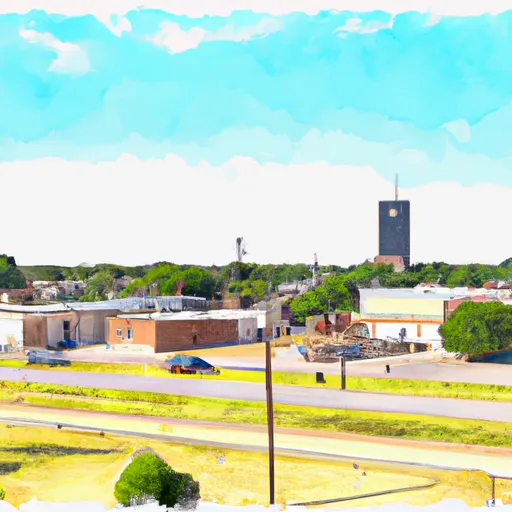-
 Snoflo Premium
Snoflo Premium
Get unlimited access to all our content
With no Ad interruptions! - Start Your Free Trial Login with existing account
Tuttle
Eden Index
Climate
8.3
•
Recreation
2.5
•
Community
3.0
•
Safeguard
4.9/10

Tuttle, Oklahoma is a small town located in Grady County, just southwest of Oklahoma City. The climate in Tuttle is classified as humid subtropical, characterized by hot summers and mild winters. Summers are typically hot and humid, with temperatures often reaching the 90s°F (32°C) and occasional thunderstorms. Winters are generally mild, with temperatures ranging from the 30s°F (around 0°C) to the 50s°F (10-15°C).
When it comes to hydrology constituents, Tuttle is situated near the Canadian River, which flows through the region. The river serves as a vital water source for both wildlife and local communities.
Tuttle offers various outdoor recreation opportunities for nature enthusiasts. The town is surrounded by scenic landscapes, including fields, forests, and rolling hills. These areas provide excellent opportunities for hiking, camping, and wildlife observation. The Canadian River also offers opportunities for fishing, boating, and kayaking.
Overall, Tuttle, Oklahoma offers a pleasant climate with distinct seasons, access to the Canadian River, and numerous outdoor recreational activities for residents and visitors to enjoy.
What is the Eden Index?
The Snoflo Eden Index serves as a comprehensive rating system for regions, evaluating their desirability through a holistic assessment of climate health, outdoor recreation opportunities, and natural disaster risk, acknowledging the profound impact of these factors on livability and well-being.
Climate Health Indicator (CHI): 8.3
Tuttle receives approximately
888mm of rain per year,
with humidity levels near 80%
and air temperatures averaging around
16°C.
Tuttle has a plant hardyness factor of
7, meaning
plants and agriculture in this region tend to thrive during the non-winter months.
By considering the ideal temperature range, reliable water supplies, clean air, and stable seasonal rain or snowpacks, the Climate Health Indicator (CHI) underscores the significance of a healthy climate as the foundation for quality living.
A healthy climate is paramount for ensuring a high quality of life and livability in a region, fostering both physical well-being and environmental harmony. This can be characterized by ideal temperatures, reliable access to water supplies, clean air, and consistent seasonal rain or snowpacks.
Weather Forecast
Streamflow Conditions
Lower Canadian
Area Rivers
Lower Canadian
Snowpack Depths
Lower Canadian
Reservoir Storage Capacity
Lower Canadian
Groundwater Levels
Recreational Opportunity Index (ROI): 2.5
The Recreational Opportunity Index (ROI) recognizes the value of outdoor recreational options, such as parks, hiking trails, camping sites, and fishing spots, while acknowledging that climate plays a pivotal role in ensuring the comfort and consistency of these experiences.
Access to outdoor recreational opportunities, encompassing activities such as parks, hiking, camping, and fishing, is crucial for overall well-being, and the climate plays a pivotal role in enabling and enhancing these experiences, ensuring that individuals can engage in nature-based activities comfortably and consistently.
Camping Areas
| Campground | Campsites | Reservations | Toilets | Showers | Elevation |
|---|---|---|---|---|---|
| Clear Creek Lake | None | 1,181 ft | |||
| Taylor Lake | 20 | 1,289 ft | |||
| Fuqua Lake | None | 1,117 ft | |||
| Schrock Park | None | 1,305 ft | |||
| Boone Park - Lake Nocona | None | 844 ft | |||
| Weldon Rob Memorial Park - Lake Nocona | 20 | 864 ft | |||
| Joe Benton Park - Lake Nocona | None | 852 ft |
Nearby Fishing
Nearby Ski Areas
Catastrophe Safeguard Index (CSI):
The Catastrophe Safeguard Index (CSI) recognizes that natural disaster risk, encompassing floods, fires, hurricanes, and tornadoes, can drastically affect safety and the overall appeal of an area.
The level of natural disaster risk in a region significantly affects safety and the overall livability, with climate change amplifying these risks by potentially increasing the frequency and intensity of events like floods, fires, hurricanes, and tornadoes, thereby posing substantial challenges to community resilience and well-being.
Community Resilience Indicator (CRI): 3.0
The Community Resilience Indicator (CRI) recognizes that education, healthcare, and socioeconomics are crucial to the well-being of a region. The CRI acknowledges the profound impact of these elements on residents' overall quality of life. By evaluating educational resources, healthcare accessibility, and economic inclusivity, the index captures the essential aspects that contribute to a thriving community, fostering resident satisfaction, equity, and social cohesion.

